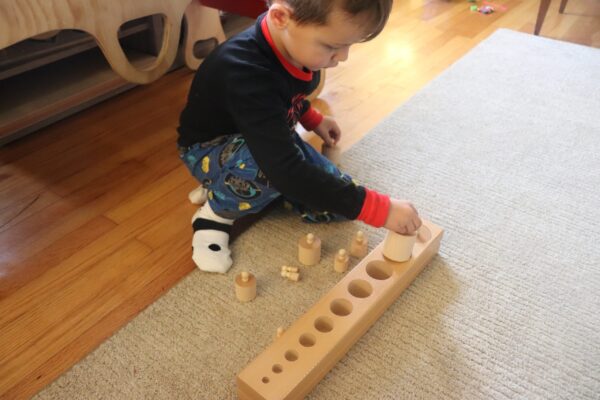Montessori Knobbed Cylinders
One of my favorite sensorial materials is the Montessori Knobbed Cylinders. This is a material designed by Dr. Montessori, herself and it is typically the first sensorial material children are introduced to in a traditional Montessori program.
The reason this is a favorite of mine is that it is an activity my children can do on their own because the control of error is built into the material; that means the child cannot pair them incorrectly…it just isn't possible!
Another reason i love it so much is that my kids enjoy it! To them, it is just a fun pairing game!
Knobbed Cylinders: math and fine motor skills
I know the reasoning behind the activity, though. It is so much more than just a game.
This activity is the first of the sensorial materials that introduce the child to the characteristics and language of dimensions.
Through their work with these cylinders, the child's ability to discriminate visually becomes refined.
This is a pre-math activity and a pre-writing activity, as the knobs on the cylinders help develop the fine motor movements needed for future writing.
How neat is that!? A fun activity that helps kids with future learning!
Presentation of Montessori Knobbed Cylinders
The presentation of the Knobbed Cylinders is simple; almost self-explanatory, though the blocks of cylinders should be presented in order of the degree of difficulty; simplest to most difficult.

You may want to suggest, after the removal of all the cylinders, that the child stand up, so they can visualize from above, the dimensions.
This will help them be successful in their pairing attempts. Turning each cylinder upside down and visualizing its base is part of the activity, as well.
There are several extensions of this activity to try after the child is successful with all 4 cylinder blocks; reverse pairing, doing multiple blocks together, and memory exercises.
My daughter's absolute favorite extension, though, involves being blindfolded during the activity!

“Why blindfold?”, you might ask. Well, the answer is really cool.
By performing the activity blindfolded, the child is using a higher brain function than without the blindfold.
The child's brain must combine multiple sensory inputs simultaneously.
Due to the lack of visualization, the child has to use their tactile and muscular senses.
Knobbed Cylinders vocabulary
Along with every Montessori activity comes new vocabulary.
For the Knobbed Cylinders, the words thick, thicker, thickest, thin, thinner, thinnest, and short, shorter, shortest can be introduced.
In this activity, there is also an opportunity to discuss weight, diameter, and depth: all concepts that will be used in future math!
Perfect! I love it and I hope you will, too!
Cheers and don't forget to subscribe!


Pingback: What is Control of Error in Montessori? — The Montessori-Minded Mom
Pingback: What Are Montessori Activities Anyway? — The Montessori-Minded Mom